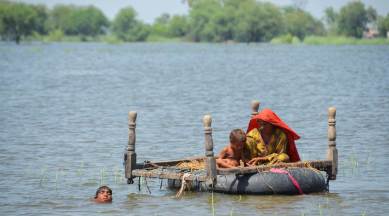Pakistan floods: Despair grips the country amid impending health and financial crises
Even as the Shehbaz Sharif government is yet to decide on importing fruits and vegetables from India, several business organisations are urging it to import essential food items like onions and tomatoes.

With floodwater from northern Pakistan entering the southern half on Thursday, authorities braced for more flooding. A surge of water flowed down the Indus river, compounding the devastation in the country, where record monsoon rains and melting glaciers in the north have triggered floods, killing at least 1,191 people, including 399 children.
Since June, rains have washed away buildings, submerged homes and destroyed roads, and one-third of the country is underwater.
monthly limit of free stories.
with an Express account.
Pakistan’s CPI at multi-decade high
Pakistan’s consumer price index (CPI) surged to a multi-decade high of 27.3% in August from a year earlier, according to government data released on Thursday. Authorities warn the current floods in the country could exacerbate the already skyrocketing prices.
Price rises in staples, including vegetables, wheat and cooking oil led to the high inflation, the Pakistan Bureau of Statistics said in a statement. In July, annual CPI inflation was at 24.9%. Economists said August’s inflation was the highest in more than 40 years.
Pakistan mulling to import food from India
Despite ties between New Delhi and Islamabad being not at its best, calls for opening trade routes with India are gaining momentum among the authorities in the latter, owing to the spiked prices of vegetables and fruits due to the catastrophic floods that have destroyed farmlands spanning thousands of acres.
Even as the Shehbaz Sharif government is yet to decide on the import of fruits and vegetables from India, several business organisations are urging it to import essential food items like onions and tomatoes.
Impending disease outbreak
As waters from the floods that ravaged areas in Pakistan, such as Sindh, Balochistan, southern Punjab and Khyber Pakhtunkhwa, over the last month have started receding, health experts warn of an impending health crisis that might hit the South-Asian country, which is already reeling under financial and food shortage crises.
On Wednesday, officials in Pakistan and the World Health Organization (WHO) warned that the devastating floods, which cost the country at least $10 billion and affected over 33 million people, could spread water-borne diseases, such as diarrhea, cholera, gastroenteritis, typhoid and skin infections. It is estimated that at least 5 million people in the country will fall sick in the coming weeks and the disease outbreak would initially require medicines and medical supplies worth Rs 1 billion.
Support from the UN and worldwide
As calls for aid from the flood-ravaged country grow louder, the United Nations on Tuesday launched a $160 million plan to help the “unprecedented climate catastrophe”. “The Pakistani people are facing a monsoon on steroids – the relentless impact of epochal levels of rain and flooding,” U.N. Secretary-General Antonio Guterres said.
Despite long-standing disputes with its neighbour, India is considering extending humanitarian assistance to Pakistan. If the plan goes through, this would be the first time since the BJP government came to power in 2014 that India will be extending aid to Pakistan on account of a natural disaster. On Wednesday, Pakistan Prime Minister Shehbaz Sharif thanked Prime Minister Narendra Modi for sending condolences to Pakistan flood victims.
Condolences poured in from the White House as well. “We are saddened by the tragic loss of life and destruction as a result of the severe flooding in Pakistan. We send our deepest condolences to all the individuals and families impacted. The United States stands with communities in Pakistan as they experience severe flooding and landslides,” White House Press Secretary Karen Jean-Pierre told reporters at her daily news conference here on Wednesday.
Exceptionally wet monsoon
Reports say about 110 of the 150 districts in the country are affected by the flooding. The flooding, the result of an unusually wet monsoon season in Pakistan this year, started in July, but has worsened over the last couple of weeks. The regions of Sindh and Balochistan, comprising the western half of Pakistan, have been badly hit, although Punjab and Khyber Pakhtunkhwa too have been affected.
The normal rainfall for Pakistan as a whole during this three-month monsoon season is 140 mm, according to PMD. But because the season is quite short, there is a wide variation in the monsoon rainfall every year.
This year, the country saw plenty of rain from late June itself. But August has been exceptionally wet. Pakistan’s Minister for Climate Change Sherry Rehman shared data from the Pakistan Meteorological Department (PMD) that showed until Friday, August had produced two and a half times its normal rainfall — 176.8 mm against the expected 50.4 mm. In Sindh, it has rained almost eight times the normal amount during this period; Balochistan has received over five times more.
(With inputs from PTI, Reuters)